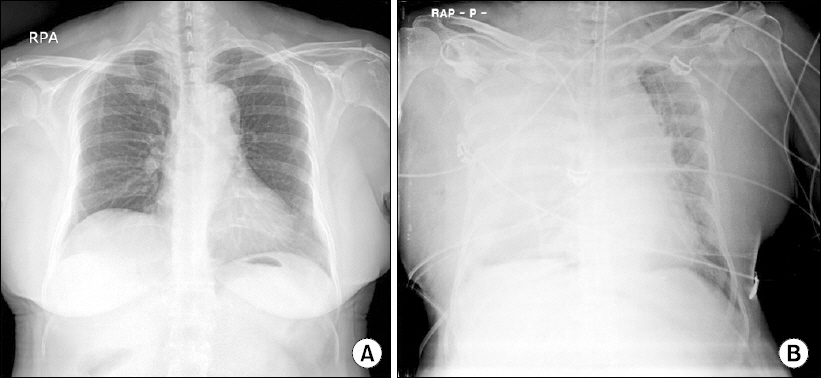Anesth Pain Med.
2017 Apr;12(2):151-154. 10.17085/apm.2017.12.2.151.
Tension hydrothorax induced by malposition of central venous catheter: A case report
- Affiliations
-
- 1Department of Anesthesiology and Pain Medicine, Busan Paik Hospital, Inje University College of Medicine, Busan, Korea. pain_kill@naver.com
- KMID: 2379736
- DOI: http://doi.org/10.17085/apm.2017.12.2.151
Abstract
- Central venous catheterization is a useful method for monitoring central venous pressure and maintaining volume status. However, it is associated with several complications, such as pneumothorax, hydrothorax, hemothorax, and air embolism. Here we describe a case of iatrogenic tension hydrothorax after rapid infusion of fluid into the pleural space, following the misplacement of an internal jugular vein catheter. Despite ultrasonographic guidance during insertion of the central venous catheter, we were not able to avoid malposition of the catheter. The patient went into hemodynamic compromise during surgery, necessitating chest tube drainage and a mechanical ventilator postoperatively. This case shows that central venous catheter insertion under ultrasonographic guidance does not guarantee proper positioning of the catheter.
Keyword
MeSH Terms
Figure
Reference
-
1. McGee DC, Gould MK. Preventing complications of central venous catheterization. N Engl J Med. 2003; 348:1123–33. DOI: 10.1056/NEJMra011883. PMID: 12646670.2. Tilak MD, Proctor SM, Donovan JF Jr, Fitch JC. Extravascular placement of a central venous catheter in the mediastinum. J Cardiothorac Vasc Anesth. 2004; 18:75–7. DOI: 10.1053/j.jvca.2003.10.016. PMID: 14973805.3. Ishibashi H, Ohta K, Ochiai T, Kaisan T, Ishikawa T, Kubota T, et al. Delayed hydrothorax induced by a pericutaneous central venous catheter;report of a case. Kyobu Geka. 2002; 55:213–5. PMID: 11889809.4. Duntley P, Siever J, Korwes ML, Harpel K, Heffner JE. Vascular erosion by central venous catheters. Clinical features and outcome. Chest. 1992; 101:1633–8. DOI: 10.1378/chest.101.6.1633. PMID: 1600785.5. Defalque RJ, Campbell C. Cardiac tamponade from central venous catheters. Anesthesiology. 1979; 50:249–52. DOI: 10.1097/00000542-197903000-00021.6. Maroun R, Chalhoub M, Harris K. Right internal jugular venous cannulation complicated by tension hydrothorax. Heart Lung. 2013; 42:372–4. DOI: 10.1016/j.hrtlng.2013.06.049. PMID: 23871236.7. Zanobetti M, Coppa A, Bulletti F, Piazza S, Nazerian P, Conti A, et al. Verification of correct central venous catheter placement in the emergency department:comparison between ultrasonography and chest radiography. Intern Emerg Med. 2013; 8:173–80. DOI: 10.1007/s11739-012-0885-7. PMID: 23242559.
- Full Text Links
- Actions
-
Cited
- CITED
-
- Close
- Share
- Similar articles
-
- Mediastinal and Intrapleural Hydrothorax Following Subclavian Central Venous Catheterization - A case report
- Central Venous Catheter-Related Hydrothorax
- Hydrothorax and Broken Catheters from Central Venous Catheterization
- Hemomediastinum Caused by Central Venous Catheter
- Loop Formation and Malposition of Subclavian Vein Catheter


